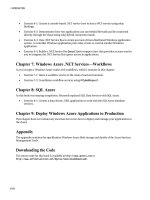Introducing Windows Azure- P3 pot
Bạn đang xem bản rút gọn của tài liệu. Xem và tải ngay bản đầy đủ của tài liệu tại đây (154.14 KB, 5 trang )
■ CONTENTS
ix
Host an Application from the Cloud 302
Deploying Cloud Applications 303
Staging Deployment 305
Select the Application Package and Configuration Package 306
Running a Hosted Application 307
Maintenance of a Cloud Application 309
Increase or Decrease the Number of Instances 310
Override the Configuration 311
Redeploy an Application with a New Version 311
Summary 311
Azure Service Management Tools 314
■Appendix 313
■Index 315
x
Foreword
Forget the buzzword-compliant prognostications of the IT pundits and forget the
fevered predictions of open vs. proprietary, because everything is changing and
changing fast. Maybe everything is changing so fast that some folks still see cloud
computing as a discussion about the future, when in fact it is real, with many
popular applications currently running in cloud environments. Cloud computing
is just a term for what has been slowly brewing on the back burner for many years.
It is the natural evolution of technology.
The evolution timeline goes something like this. In the beginning there was
the mainframe. The mainframe cost a lot and used a lot of power, so it made sense
to sell slices of time to companies needing computing power. After a while, computers became smaller
and less expensive and businesses and consumers began buying their own. But then networks began to
form, and the eventually ubiquitous Internet was born. This led the way to the idea of the application
service provider (ASP). Ah, those were the days.
Well, everyone forgot about all that stuff for a few years as the technology sector went through a
reality adjustment. But as always, business keeps moving forward. In that time a few companies began,
or shall I say fell into, the idea of the cloud more by necessity than anything else. Salesforce.com and
Amazon were so popular and successful that they sought to expand their businesses by providing
platforms that would allow developers to not only configure their applications (what used to be called
ASPs and are now called software as a service) but also customize them. But it was almost natural for
these well-architected platforms to start spawning new applications that didn’t have anything to do with
the original application, and thus we now have what is currently called cloud computing.
There is no doubt it will take years for the majority of companies to adopt cloud computing,
especially for their more mission-critical, enterprise, highly secure, or financial applications. But that is
okay, because there will be a lot of time for the companies and applications that are a perfect fit to work
out the bugs. They will pave the way for every company to take part. Because of competitive pressures
and the efficiency associated with cloud computing, it will be inevitable that most if not all companies
will use the cloud in some way.
The cost of hosting applications has traditionally been quite expensive. The first high-availability
web applications required that a company either maintain its own data center with redundant hardware
and 24-hour or on-call staff. The alternative was to pay managed services data centers thousands of
dollars per month to maintain a dedicated hosting environment. IT managers had to forecast the
processing power needed to run their applications, and often this led to an over-purchase of hardware
and software. This paradigm has led to vast data centers wasting huge amounts of power with many
thousands of servers humming along nicely with no more than two or three percent utilization. But in
the last decade, as virtual servers have evolved in both hosted and on-premise data centers, it was only a
matter of time before the technology allowed companies and applications to share processors with little
risk of one errant application affecting another.
The evolution of technology may have come full circle with utility computing (remember the
mainframe?), but it looks very different than anyone could have imagined. The inevitability of the virtual
■ FOREWORD
xi
future has played its hand in the convergence of process, platform, tools, architectures, and services, and
it is how we are currently building applications.
So let’s take a moment to explore why cloud computing will be hard to ignore in the coming years.
First of all, cloud computing by definition is inherently scalable and as reliable as any high-end managed
hosting service. We are accustomed to paying several thousand dollars a month for a handful of servers
in a traditional managed hosting environment. This has been the standard for mission-critical
applications for quite some time now. A similar entry-level cost of a fully scalable and redundant system
can cost hundreds instead of thousands often quoted by the enterprise managed hosting companies.
But probably the most important point when talking about the scalability of cloud computing is its
ability to scale up and scale down quickly, which will be very important for companies that might need
to acquire a substantial amount of processing power for a short amount of time. Now they can do so
without any long-term commitments or substantial capital expenditures.
The second benefit of cloud computing is reduced time to market for new applications. Managed
hosting companies or corporate data centers often needed weeks to months of lead time to acquire
hardware and install operating systems and database software required for most applications. Cloud
computing accounts can often be provisioned with applications deployed and made live within hours.
Last but certainly not one of the least benefits of cloud computing is that it is in line with green IT
initiatives, which are quickly becoming an integral part of corporate strategies. By sharing resources with
other organizations, we no longer have acres of server farms consuming huge amounts of power while
sitting nearly idle waiting for the peak load at some time in the future. The fact is that that peak load will
almost never happen as IT managers always err on the side of caution and purchase multiples of the
processing power they will ever actually use.
This book is an introduction to Windows Azure, Microsoft’s offering for cloud computing. Windows
Azure is not just a virtual hosting solution that infinitely scales. Nor is it just a few editing and
deployment tools tacked onto a virtual hosting solution. Windows Azure is a cloud application platform
that enables companies to build and run applications that scale in a reliable, available, and fault-tolerant
manner by providing the fundamental services every application needs. It is a suite of hosting services,
development environment, and development tools combined with a set of robust services. Some of
these services .NET developers have been working with for the last several years, and some are fairly
new.
Developers who have worked on other cloud platforms will quickly notice that in terms of
comprehensive services and features, this platform is leaps and bounds beyond any other cloud
computing platform on the market today, which is saying a lot given that Amazon and Salesforce.com
have been building and perfecting their solutions for the better part of the past decade. Microsoft has
also gone one step further and built its platforms and services in a manner that can be utilized by open
development technologies including Python, Ruby, PHP, and open protocols and standards, including
REST, SOAP, and XML.
This book will walk you through the development process with a detailed set of exercises. With the
many screenshots and code samples included, you can expect to be developing full-blown Windows
Azure applications that use almost every service and feature currently offered.
Your first steps in learning the Windows Azure platform will be to understand and utilize the cloud
table, queue, and blob storage services. You will walk through the process of integration using Windows
Communication Foundation (WCF) and Windows Workflow Foundation (WF). Next you will explore the
Windows .NET Access Control Service, the Service Bus, and workflows that allow you to coordinate
services and build distributed connected applications. You will explore SQL Data Services in depth, and
the final chapter explains how to deploy your applications into a production environment.
As with any new development technology introduced by Microsoft, there will be a steep learning
curve and lots of new terminology and concepts to understand. On the bright side, just as with the
introduction of .NET, Window Presentation Foundation, or Windows Communication Foundation, you
will not be alone in your quest. You will have lots of great resources to help you along the way, and
■ FOREWORD
xii
Henry’s book is certainly a great place to start. This will be another big programming paradigm shift for
programmers, so fully understanding the contents of this book will be a big start in the process of
learning this new and relevant technology.
I wish you all the best in your new adventures of developing applications for the Windows Azure
platform.
Bruce Wilson, CTO, Planned Marketing Solutions International
xiii
About the Author
■Henry Li is a technical consultant, specializing in enterprise application
integration and distributed system automation solutions. He runs his own
consulting firm SoftnetSolutions Consulting, Inc., based in Hillsboro, Oregon,
delivering business solutions for large-scale enterprises, government agencies,
and small businesses.
He has been engaged in numerous large-scale middleware infrastructures,
front-end and back-end architecture designs, and implementations based upon
Microsoft .NET and BizTalk technologies. He has served clients across the United
States, including diverse enterprise organizations, government agencies,
semiconductor manufacturers, and industry equipment facility manufacturers. He also has intensive
experience designing data-driven, event-driven industry automation solutions using XML and design
patterns. He strongly believes that object-oriented programming is not only a software development
technology but also a philosophy that should be applied to any analysis of business solution architecture
design.
Henry Li resides with his wife, Wenyan, and lovely daughter, Emma, who is an all-A-qualified
swimmer of the USA Swimming Society, in the beautiful Portland metro area of Oregon. He can be
contacted at with any questions regarding this book and his most-
interested-in areas, SOA (service-oriented architecture), AOP (aspect-oriented programming), and XML
data-driven solutions.









